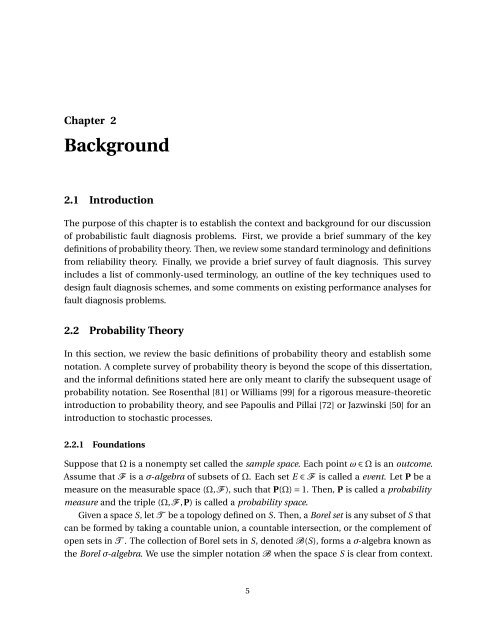Probabilistic Performance Analysis of Fault Diagnosis Schemes
Probabilistic Performance Analysis of Fault Diagnosis Schemes
Probabilistic Performance Analysis of Fault Diagnosis Schemes
Create successful ePaper yourself
Turn your PDF publications into a flip-book with our unique Google optimized e-Paper software.
Chapter 2<br />
Background<br />
2.1 Introduction<br />
The purpose <strong>of</strong> this chapter is to establish the context and background for our discussion<br />
<strong>of</strong> probabilistic fault diagnosis problems. First, we provide a brief summary <strong>of</strong> the key<br />
definitions <strong>of</strong> probability theory. Then, we review some standard terminology and definitions<br />
from reliability theory. Finally, we provide a brief survey <strong>of</strong> fault diagnosis. This survey<br />
includes a list <strong>of</strong> commonly-used terminology, an outline <strong>of</strong> the key techniques used to<br />
design fault diagnosis schemes, and some comments on existing performance analyses for<br />
fault diagnosis problems.<br />
2.2 Probability Theory<br />
In this section, we review the basic definitions <strong>of</strong> probability theory and establish some<br />
notation. A complete survey <strong>of</strong> probability theory is beyond the scope <strong>of</strong> this dissertation,<br />
and the informal definitions stated here are only meant to clarify the subsequent usage <strong>of</strong><br />
probability notation. See Rosenthal [81] or Williams [99] for a rigorous measure-theoretic<br />
introduction to probability theory, and see Papoulis and Pillai [72] or Jazwinski [50] for an<br />
introduction to stochastic processes.<br />
2.2.1 Foundations<br />
Suppose that Ω is a nonempty set called the sample space. Each point ω ∈ Ω is an outcome.<br />
Assume that F is a σ-algebra <strong>of</strong> subsets <strong>of</strong> Ω. Each set E ∈ F is called a event. Let P be a<br />
measure on the measurable space (Ω,F ), such that P(Ω) = 1. Then, P is called a probability<br />
measure and the triple (Ω,F , P) is called a probability space.<br />
Given a space S, let T be a topology defined on S. Then, a Borel set is any subset <strong>of</strong> S that<br />
can be formed by taking a countable union, a countable intersection, or the complement <strong>of</strong><br />
open sets in T . The collection <strong>of</strong> Borel sets in S, denoted B(S), forms a σ-algebra known as<br />
the Borel σ-algebra. We use the simpler notation B when the space S is clear from context.<br />
5













